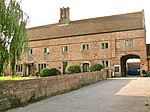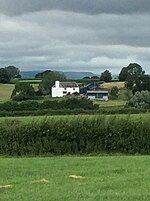Raglan Castle

Raglan Castle (Welsh: Castell Rhaglan) is a late medieval castle located just north of the village of Raglan in the county of Monmouthshire in south east Wales. The modern castle dates from between the 15th and early 17th centuries, when the successive ruling families of the Herberts and the Somersets created a luxurious, fortified castle, complete with a large hexagonal keep, known as the Great Tower or the Yellow Tower of Gwent. Surrounded by parkland, water gardens and terraces, the castle was considered by contemporaries to be the equal of any other in England or Wales. During the First English Civil War, Raglan was occupied by a Royalist garrison on behalf of Charles I but was taken by Parliamentarian forces in 1646 and its walls slighted, or deliberately put beyond military use. After the Stuart Restoration in 1660, the Somersets declined to restore it and it became first a source of local building materials, then a romantic ruin. It is now a tourist attraction.
Excerpt from the Wikipedia article Raglan Castle (License: CC BY-SA 3.0, Authors, Images).Raglan Castle
Castle Road,
Geographical coordinates (GPS) Address External links Nearby Places Show on map
Geographical coordinates (GPS)
| Latitude | Longitude |
|---|---|
| N 51.7703 ° | E -2.8521 ° |
Address
Raglan Castle
Castle Road
NP15 2BT , Raglan
Wales, United Kingdom
Open on Google Maps








